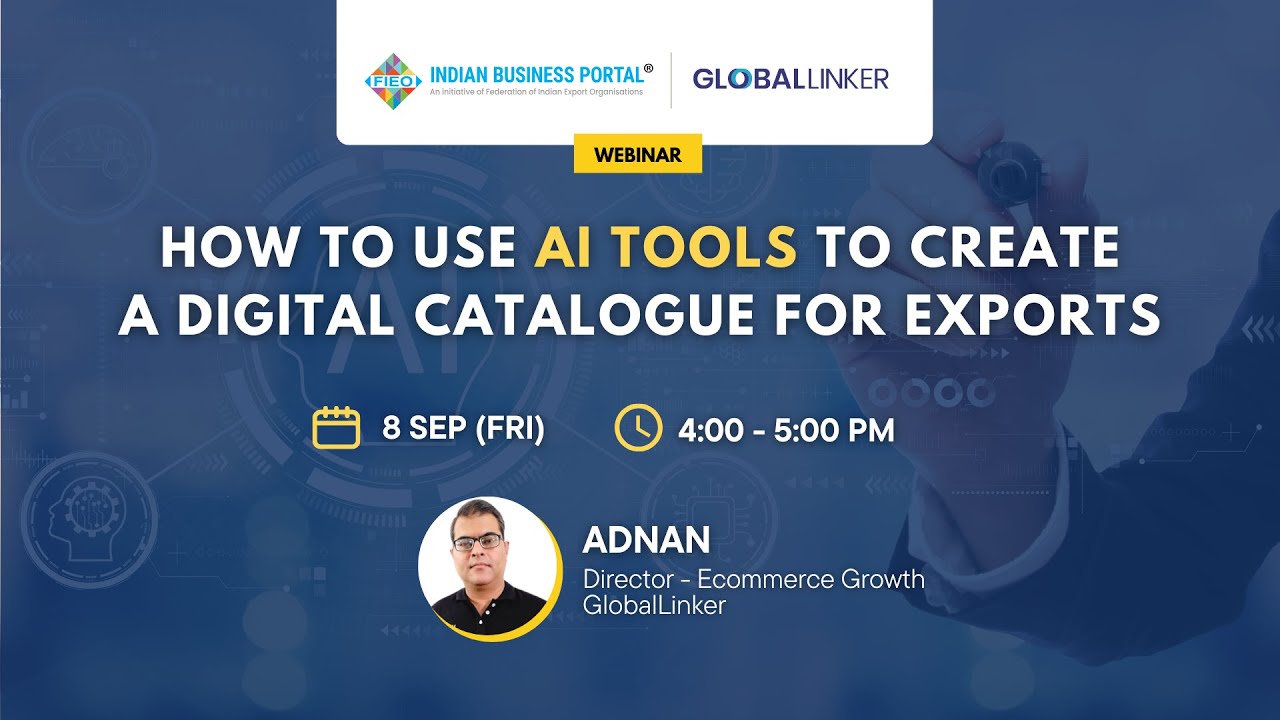
We are thrilled to invite you to a webinar hosted by GlobalLinker on September 8th, 2023. The webinar will focus on using AI tools to create and optimize digital catalogs for export businesses. This engaging session will cover key topics such as the role of AI in creating export-focused digital catalogs, using available AI tools for export businesses, best practices for maximizing business growth with AI tools, and a live Q&A session. Whether you’re a business owner, export manager, marketing professional, or simply interested in using AI for export growth, this webinar is highly recommended.
During the webinar, participants will learn about the process of using AI tools to generate product titles, descriptions, and keywords for their digital catalogs. The importance of having a strong digital presence and quality content will also be emphasized. Additionally, participants will receive a demonstration on how to upload products, create navigation, and add content pages, as well as create logos and banners using AI tools. Questions from participants will be addressed, covering various topics such as listing products on the platform, the best social media platform for lead generation, and integrating AI tools with other platforms. Join us for this enlightening webinar and discover the power of AI in enhancing your export business.

Understanding the Role of AI in Creating Export-Focused Digital Catalogs
In today’s competitive business landscape, having a strong digital presence is essential for export businesses. One of the key components of a successful digital presence is a well-designed and optimized digital catalog. This is where the role of AI (Artificial Intelligence) comes into play. AI can revolutionize the way export businesses create and manage their digital catalogs, making the process more efficient, accurate, and impactful.
AI tools have the capability to analyze vast amounts of data and generate valuable insights that can help export businesses make informed decisions. These tools can automate and streamline various tasks involved in creating a digital catalog, such as generating product titles, descriptions, and keywords. By leveraging AI, businesses can save time and resources while ensuring the quality and relevancy of their catalog content.
AI also enables businesses to gain a deeper understanding of their target market and customers. Through data analysis and machine learning algorithms, AI tools can identify trends, preferences, and customer behavior patterns. This information can be used to tailor the digital catalog to meet the specific needs and preferences of the target market, increasing the chances of attracting and converting potential customers.
Furthermore, AI tools can assist export businesses in optimizing their digital catalogs for search engines and online marketplaces. By automatically generating relevant keywords, tags, and metadata, AI can help improve the visibility and searchability of the catalog in search engines and platforms like Amazon or Alibaba. This, in turn, increases the chances of reaching a wider audience and driving more traffic to the catalog.
Overall, AI plays a crucial role in creating export-focused digital catalogs by automating tasks, improving content quality, enhancing customer targeting, and optimizing catalog visibility. By leveraging the power of AI tools, export businesses can stay ahead of the competition, drive business growth, and maximize their export potential in the digital marketplace.
Using Available AI Tools for Export Businesses
The availability of AI tools for export businesses has grown significantly in recent years. Many software providers, both large and small, have developed AI-powered solutions specifically tailored for the export industry. These tools offer a wide range of functionalities, such as product content generation, data analysis, customer segmentation, and search engine optimization.
When choosing AI tools for your export business, it is important to consider your specific needs, budget, and technical capabilities. Some AI tools require advanced technical knowledge and integration with existing systems, while others are more user-friendly and offer ready-to-use solutions. It is essential to evaluate the features, scalability, and compatibility of AI tools before making a decision.
Additionally, it can be beneficial to seek recommendations and reviews from other export businesses who have already implemented AI tools. Online forums, industry conferences, and webinars like the one hosted by GlobalLinker can provide valuable insights and recommendations from experienced professionals in the field.
Best Practices for Maximizing Business Growth with AI Tools
Implementing AI tools in your export business requires proper planning and execution to ensure maximum effectiveness and return on investment. Here are some best practices to consider when using AI tools for business growth:
-
Set Clear Objectives: Clearly define your business goals and objectives before implementing AI tools. Determine what specific outcomes you expect to achieve with the help of these tools, such as increasing sales, improving customer satisfaction, or expanding into new markets.
-
Choose the Right Tools: Conduct thorough research and evaluate different AI tools available in the market. Choose tools that align with your business requirements, technical capabilities, and budget. Consider factors such as ease of use, integration capabilities, scalability, and customer support.
-
Train Your Team: Provide adequate training to your team members on how to effectively use and leverage AI tools. Ensure they understand the functionalities, features, and benefits of the tools and how they can contribute to overall business growth.
-
Data Quality Assurance: Ensure the accuracy and quality of the data used by AI tools. Regularly review and update data sources to keep the AI algorithms accurate and up-to-date. Implement data cleansing and validation processes to minimize errors and inaccuracies in the AI-generated content.
-
Monitor and Evaluate Performance: Continuously monitor and evaluate the performance of AI tools in achieving your business objectives. Use analytics and reporting features to measure the impact of AI on key performance indicators (KPIs) such as sales, customer engagement, and website traffic. Make necessary adjustments and improvements based on the insights gained.
-
Stay Updated with Industry Trends: Keep up to date with the latest trends and advancements in AI technology. Regularly attend industry conferences, webinars, and training sessions to stay informed about new AI tools and techniques that can further enhance your export business.
By following these best practices, export businesses can harness the full potential of AI tools and drive significant business growth in the digital marketplace.
The Process of Using AI Tools to Generate Product Titles, Descriptions, and Keywords
One of the key features offered by AI tools is the ability to automatically generate product titles, descriptions, and keywords for digital catalogs. This process can greatly streamline and expedite the content creation process, eliminating the need for manual input and research.
The AI algorithms used in these tools analyze multiple data sources, including product attributes, customer reviews, competitor analysis, and market trends. Based on this analysis, the AI tool generates optimized and relevant product titles, descriptions, and keywords.
The process generally involves the following steps:
-
Data Collection: The AI tool collects relevant data from various sources, such as product databases, online marketplaces, and customer reviews. The tool analyzes this data to understand the key characteristics and features of the product.
-
Data Analysis: The AI algorithms analyze the collected data and identify patterns, trends, and common themes. This analysis helps the tool generate accurate and impactful product titles, descriptions, and keywords.
-
Title Generation: The tool uses the analyzed data to generate a concise and informative product title. The title is designed to capture the attention of potential customers and convey the unique selling proposition of the product.
-
Description Generation: The AI tool generates a detailed and compelling product description based on the analyzed data. The description highlights the key features, benefits, and specifications of the product, enticing customers to make a purchase.
-
Keyword Generation: Using the data analysis, the AI tool generates a list of relevant keywords that are optimized for search engine visibility. These keywords improve the catalog’s searchability and increase the chances of reaching potential customers.
-
Review and Refinement: The AI-generated content is reviewed by the export business owner or marketing team to ensure accuracy, relevancy, and brand consistency. Any necessary refinements or customizations can be made at this stage.
By leveraging AI tools for content generation, export businesses can save time, improve content quality, and optimize catalog visibility. This process allows businesses to focus on other strategic aspects of their export operations while ensuring their digital catalog is engaging and accessible to potential customers.

The Importance of Having a Strong Digital Presence and Quality Content
In the digital age, having a strong online presence is crucial for export businesses to reach a wider audience and grow their export potential. A well-designed and optimized digital catalog is the cornerstone of a strong digital presence. Such a catalog serves as a virtual storefront and helps businesses showcase their products to potential customers around the world.
To create a successful digital catalog, it is essential to focus on quality content. Content is what drives customer engagement, attracts organic search traffic, and ultimately leads to conversions. AI tools can play a significant role in creating high-quality content that resonates with the target audience.
High-quality content is informative, engaging, and tailored to the needs and preferences of the target market. It showcases the unique selling points of the products, provides detailed information, and communicates the brand’s values and story. AI tools can assist in generating content that meets these criteria by analyzing market trends, customer preferences, and competitor data.
Furthermore, quality content is essential for search engine optimization (SEO) and improving the overall visibility of the digital catalog. Search engines prioritize content that is relevant, informative, and user-friendly. By using AI tools to generate optimized content, export businesses can increase their chances of ranking higher in search engine results and attracting organic traffic.
In addition to text content, visual elements such as images and videos also play a crucial role in creating a strong digital presence. AI tools can be used to enhance visuals by generating professional-looking logos, banners, and product images. These visually appealing elements help create a cohesive and visually engaging digital catalog.
Overall, having a strong digital presence and quality content is vital for export businesses to stand out in the competitive digital marketplace. AI tools can assist businesses in creating compelling content that attracts visitors, improves SEO, and ultimately drives business growth.
Uploading Products, Creating Navigation, and Adding Content Pages
After generating the product titles, descriptions, and keywords using AI tools, it’s time to upload the products to the digital catalog and create a user-friendly navigation system. Additionally, content pages can be added to provide valuable information, enhance user experience, and promote the brand.
The process generally involves the following steps:
-
Product Upload: Export businesses can use the AI-generated product content to upload their products to the digital catalog. This involves adding product images, pricing information, stock details, and other relevant attributes. The AI-generated content can be directly copied and pasted into the product description fields.
-
Navigation Creation: To ensure a user-friendly browsing experience, it is important to create clear and intuitive navigation menus. Businesses can organize their products into categories and subcategories, making it easy for customers to find what they are looking for. AI tools can help analyze the product attributes and suggest appropriate categories for each product.
-
Content Page Creation: Content pages provide an opportunity to showcase additional information about the business, its values, and its unique selling propositions. Businesses can create pages such as “About Us,” “FAQs,” “Shipping and Returns,” and “Contact Us.” AI tools can generate relevant content for these pages based on the business profile and industry best practices.
-
Customization and Review: After uploading the products and creating the navigation and content pages, businesses can customize the design and layout of their digital catalog. This includes selecting color schemes, fonts, and image sizes that align with the brand identity. The AI-generated content can be reviewed and refined to ensure accuracy, relevancy, and brand consistency.
-
Optimization for Mobile Devices: It is essential to optimize the digital catalog for mobile devices, as a large percentage of customers access online catalogs through smartphones and tablets. AI tools can help ensure that the catalog is responsive and compatible with different screen sizes and resolutions.
By following these steps, export businesses can create a user-friendly, visually appealing, and informative digital catalog that effectively showcases their products and engages potential customers.

Creating a Logo and Banners Using AI Tools
Visual elements such as a logo and banners play a crucial role in creating a strong brand identity and enhancing the visual appeal of the digital catalog. AI tools can assist export businesses in creating professional-looking logos and banners that align with their brand image and target market.
The process of creating a logo and banners using AI tools typically involves the following steps:
-
Brand Analysis: AI tools analyze the brand identity, including the business name, industry, target audience, and brand values. This analysis helps the AI algorithms generate design recommendations that align with the brand image and target market.
-
Design Generation: Based on the brand analysis, AI tools generate multiple logo and banner design options. These designs often include color schemes, font styles, and visual elements that resonate with the target market. Export businesses can choose from these design options or provide feedback to further refine the designs.
-
Customization: Once the initial designs are generated, export businesses can further customize the logo and banners to fit their specific requirements. This may include adding text, adjusting colors, resizing the designs, and incorporating additional elements.
-
Review and Selection: The AI-generated logo and banner designs can be reviewed by the export business owner or marketing team. Feedback can be provided, and necessary adjustments can be made to ensure the final designs accurately represent the brand and meet the business’s expectations.
-
Download and Implementation: After finalizing the logo and banners, they can be downloaded and implemented in the digital catalog. Export businesses can follow the design guidelines provided by the AI tool to ensure the logos and banners are displayed correctly and consistently throughout the catalog.
By using AI tools for logo and banner creation, export businesses can save time and resources, ensuring a visually appealing and professional-looking digital catalog that leaves a lasting impression on potential customers.
Addressing Questions from Participants
During the webinar session, participants had the opportunity to ask questions and seek clarifications on various topics related to using AI tools for creating digital catalogs for export businesses. Here are some of the questions that were addressed during the session:
-
Question: How do I select the most suitable AI tool for my export business?
Answer: When selecting an AI tool, consider your specific requirements, budget, and technical capabilities. Research different AI tools available in the market, evaluate their features and compatibility with your existing systems. Seek recommendations from other export businesses who have already used AI tools, and reach out to the customer support teams of the AI tool providers for further clarification.
-
Question: Can AI tools generate content in multiple languages to cater to international customers?
Answer: Yes, many AI tools have the capability to generate content in multiple languages. This can be useful for export businesses targeting international customers. However, it is important to ensure the accuracy and quality of the AI-generated translations, as machine translations may not always capture the nuances and cultural sensitivities of different languages.
-
Question: How do AI tools help improve search engine optimization (SEO) for a digital catalog?
Answer: AI tools can assist in improving SEO by generating relevant and optimized product titles, descriptions, and keywords. These AI-generated content elements increase the catalog’s visibility in search engine results and make it easier for potential customers to find the products. Additionally, AI tools can analyze market trends, competitor data, and customer preferences to identify SEO opportunities and provide recommendations for improving the catalog’s search engine rankings.
-
Question: Can AI tools integrate with other platforms, such as social media or e-commerce marketplaces?
Answer: Many AI tools offer integration capabilities with popular platforms, such as social media platforms and e-commerce marketplaces. These integrations enable export businesses to streamline their operations, automate tasks, and synchronize data between different platforms. It is advisable to check the integration options provided by the AI tool and ensure compatibility with the platforms you are using.
These are just a few examples of the questions addressed during the webinar session. The Q&A session provided participants with an opportunity to gain further insights and guidance on leveraging AI tools for their export businesses.

Listing Specific Products on the Platform
Once the digital catalog is created using AI tools and the necessary customization is done, it’s time to list specific products on the platform. Listing specific products ensures that potential customers can easily find and access the products they are interested in purchasing.
Here are some steps to effectively list specific products on the platform:
-
Categorize Products: Divide your products into relevant categories and subcategories. This helps potential customers navigate the catalog more easily and find the specific products they are looking for. AI tools can assist in organizing products based on attributes and recommending appropriate categories.
-
Add Product Details: Provide detailed and accurate information about each product. This includes product specifications, features, dimensions, materials, and any certifications or compliance information. AI tools can generate standardized product description templates with placeholders for specific product details.
-
Include Product Images: High-quality product images play a crucial role in attracting customers and showcasing the products accurately. Take clear and visually appealing images of each product from different angles. AI tools can assist in enhancing the images by adjusting brightness, contrast, and other visual attributes.
-
Set Pricing and Inventory: Determine the pricing for each product and ensure it is competitive in the market. AI tools can provide insights on pricing strategies based on market trends and competitor analysis. Set up an inventory management system to track the availability and stock levels of each product.
-
Optimize Product Titles and Descriptions: Review and optimize the AI-generated product titles and descriptions to ensure they accurately represent the products and incorporate relevant keywords. This increases the chances of the products appearing in search engine results and attracting potential customers.
-
Include Product Variants: If your products come in different variants, such as size, color, or packaging options, ensure that each variant is clearly listed and differentiated. Provide all the necessary details for each variant, such as SKU numbers, prices, and availability.
-
Implement Customer Reviews: Encourage customers to leave reviews and ratings for your products. Positive customer reviews build trust and credibility, making it more likely for potential customers to choose your products over competitors’. AI tools can monitor and analyze customer reviews to identify areas for improvement and provide actionable insights.
By following these steps, export businesses can effectively list their specific products on the platform, making it easier for potential customers to find and purchase the products they need.
Conclusion
The use of AI tools in creating export-focused digital catalogs is transforming the way export businesses operate in the digital marketplace. These tools offer numerous benefits, such as time and resource savings, improved content quality, enhanced targeting capabilities, and increased visibility. By leveraging AI tools, export businesses can maximize their business growth potential and stay ahead in the competitive global market.
This webinar provided valuable insights into the role of AI in digital catalog creation, the use of available AI tools, best practices for business growth with AI, and the process of generating product titles, descriptions, and keywords using AI. Participants had the opportunity to ask questions and gain practical guidance on various aspects related to using AI tools for their export businesses.
By understanding and implementing the concepts discussed in this webinar, export businesses can take a significant step towards creating an impactful digital presence, reaching a wider audience, and achieving export success in the digital era.



